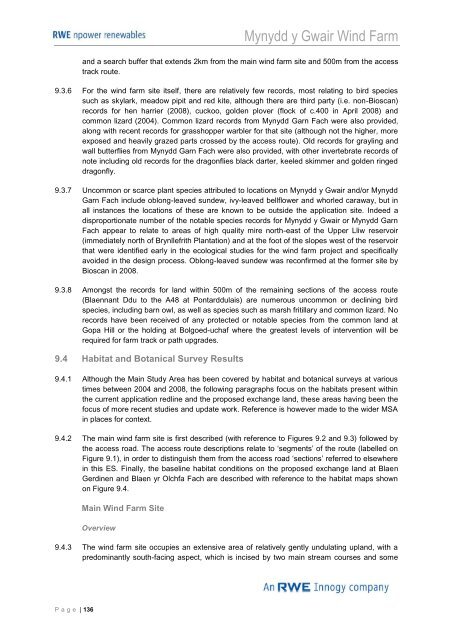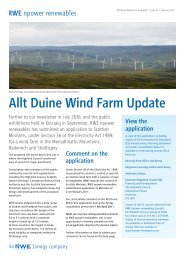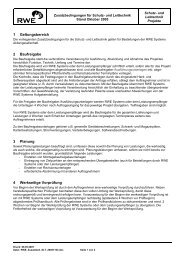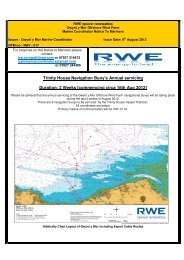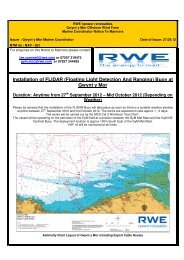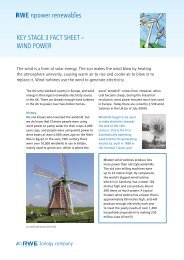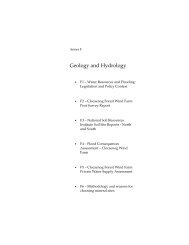Mynydd y Gwair Wind Farm - RWE.com
Mynydd y Gwair Wind Farm - RWE.com
Mynydd y Gwair Wind Farm - RWE.com
You also want an ePaper? Increase the reach of your titles
YUMPU automatically turns print PDFs into web optimized ePapers that Google loves.
P a g e | 136<br />
<strong>Mynydd</strong> y <strong>Gwair</strong> <strong>Wind</strong> <strong>Farm</strong><br />
and a search buffer that extends 2km from the main wind farm site and 500m from the access<br />
track route.<br />
9.3.6 For the wind farm site itself, there are relatively few records, most relating to bird species<br />
such as skylark, meadow pipit and red kite, although there are third party (i.e. non-Bioscan)<br />
records for hen harrier (2008), cuckoo, golden plover (flock of c.400 in April 2008) and<br />
<strong>com</strong>mon lizard (2004). Common lizard records from <strong>Mynydd</strong> Garn Fach were also provided,<br />
along with recent records for grasshopper warbler for that site (although not the higher, more<br />
exposed and heavily grazed parts crossed by the access route). Old records for grayling and<br />
wall butterflies from <strong>Mynydd</strong> Garn Fach were also provided, with other invertebrate records of<br />
note including old records for the dragonflies black darter, keeled skimmer and golden ringed<br />
dragonfly.<br />
9.3.7 Un<strong>com</strong>mon or scarce plant species attributed to locations on <strong>Mynydd</strong> y <strong>Gwair</strong> and/or <strong>Mynydd</strong><br />
Garn Fach include oblong-leaved sundew, ivy-leaved bellflower and whorled caraway, but in<br />
all instances the locations of these are known to be outside the application site. Indeed a<br />
disproportionate number of the notable species records for <strong>Mynydd</strong> y <strong>Gwair</strong> or <strong>Mynydd</strong> Garn<br />
Fach appear to relate to areas of high quality mire north-east of the Upper Lliw reservoir<br />
(immediately north of Brynllefrith Plantation) and at the foot of the slopes west of the reservoir<br />
that were identified early in the ecological studies for the wind farm project and specifically<br />
avoided in the design process. Oblong-leaved sundew was reconfirmed at the former site by<br />
Bioscan in 2008.<br />
9.3.8 Amongst the records for land within 500m of the remaining sections of the access route<br />
(Blaennant Ddu to the A48 at Pontarddulais) are numerous un<strong>com</strong>mon or declining bird<br />
species, including barn owl, as well as species such as marsh fritillary and <strong>com</strong>mon lizard. No<br />
records have been received of any protected or notable species from the <strong>com</strong>mon land at<br />
Gopa Hill or the holding at Bolgoed-uchaf where the greatest levels of intervention will be<br />
required for farm track or path upgrades.<br />
9.4 Habitat and Botanical Survey Results<br />
9.4.1 Although the Main Study Area has been covered by habitat and botanical surveys at various<br />
times between 2004 and 2008, the following paragraphs focus on the habitats present within<br />
the current application redline and the proposed exchange land, these areas having been the<br />
focus of more recent studies and update work. Reference is however made to the wider MSA<br />
in places for context.<br />
9.4.2 The main wind farm site is first described (with reference to Figures 9.2 and 9.3) followed by<br />
the access road. The access route descriptions relate to „segments‟ of the route (labelled on<br />
Figure 9.1), in order to distinguish them from the access road „sections‟ referred to elsewhere<br />
in this ES. Finally, the baseline habitat conditions on the proposed exchange land at Blaen<br />
Gerdinen and Blaen yr Olchfa Fach are described with reference to the habitat maps shown<br />
on Figure 9.4.<br />
Main <strong>Wind</strong> <strong>Farm</strong> Site<br />
Overview<br />
9.4.3 The wind farm site occupies an extensive area of relatively gently undulating upland, with a<br />
predominantly south-facing aspect, which is incised by two main stream courses and some


